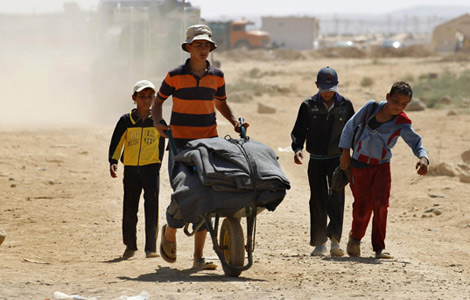Full Text: Promote Common Development Through Greater Openness and Cooperation
Updated: 2013-09-03 20:54
(Xinhua)
|
||||||||
URUMQI - Chinese Vice-President Li Yuanchao on Monday delivered a speech at the third China-Eurasia Economic Development and Cooperation Forum that opened in Urumqi, capital of Northwest China's Xinjiang Uygur autonomous region. The following is the full text of the speech.
Promote Common Development Through Greater Openness and Cooperation
Speech by H.E. Li Yuanchao
Vice President of the People's Republic of China
At the Third China-Eurasia Economic Development and Cooperation Forum
Urumqi, September 2, 2013
Since their inception in 2011, the China-Eurasia Expo and the Economic Development and Cooperation Forum have become a major platform of economic cooperation, trade and cultural exchanges between China and other Eurasian countries and an important window showcasing fresh achievements in Xinjiang's reform and opening up and its foreign exchange and cooperation. The theme of this Forum, "Openness, Mutual Trust, Common Development", reflects the shared aspiration of the governments and peoples of all Eurasian countries.
Eurasian countries are closely connected with each other. And greater openness and cooperation is a vital way leading to development and prosperity on the Eurasian continent. There are at least four reasons for this. First, geographic proximity. Many countries in the region share the same mountains and rivers. Amu Darya and Syr Darya rivers nurture countries in Central Asia. Five Eurasian countries live around the Caspian Sea. China and South Asian countries are connected by Mount Himalayas. And people in six Southeast Asian countries drink water from the same river. Second, trade connectivity. As early as 2,000 years ago, the ancient Silk Road connected the east and west ends of the Eurasian continent. Today, the Eurasian Land Bridge has become a major global trading route. China's trade with other countries in Asia and Europe totaled 2.7 trillion US dollars in 2012, including nearly 400 billion US dollars between China and countries in Central, West and South Asia. By the end of 2012, China's foreign investment stock in Central, South and West Asia reached 14.86 billion US dollars. Third, economic complimentarity. Russia and Turkmenistan's natural gas reserves account for over half of the world's total. Coal resources in countries like Kazakhstan and Mongolia are among the top in the world. Tajikistan and Kyrgyzstan have abundant water resources. Nepal has world-renowned tourist resources. China and other emerging markets have huge consumption markets and production capacities. There is vast room for economic cooperation among the Eurasian countries. Fourth, security inter-dependence. The Eurasian region is stable on the whole. Yet, local turbulences and terrorist activities happen from time to time. Faced with such threats which are often transnational, no country can stay immune. Cooperation among all countries is the only viable way to uphold regional security.
The world economy is undergoing profound changes. The trends toward economic globalization and regional integration are gaining momentum. We need to promote common development of the Eurasian region through greater openness and cooperation. Historically, the heartland in Eurasia was the most dynamic and prosperous region in the global economic landscape. There were vibrant trading activities, as west Asian merchants took horses, iron tools, linen and wool products from the West to the East, in exchange for silk, gemstones and spices. Due to multiple factors, some countries in Eurasia are yet to enter the fast track of economic development, and are faced with urgent development tasks. In order to translate the potential strengths in population, resources, market and technology into development advantages, countries in Eurasia need to further expand all-round openness and cooperation.
First, we need to advance political mutual trust and improve the security environment in the region. A proverb in Xinjiang goes, "Harmony holds the key to success." Over the years, Eurasian countries have been committed to fostering a stable and secure environment for development. The member states of the Shanghai Cooperation Organization (SCO) have jointly fought against the "three forces", namely, terrorism, separatism and extremism and effectively upheld peace and security in the region. Given that the "three forces" are still quite rampant, there is a need for countries to combat them with continued joint efforts. Eurasian countries need to establish a new security concept featuring mutual trust, mutual benefit, equality and coordination, support each other on issues concerning core national interests, strengthen cooperation on major regional issues, and jointly meet security challenges.
Second, we need to expand market openness and explore greater space for mutually beneficial cooperation. Recent years have witnessed greater openness and cooperation among Eurasian countries in such fields as trade, investment and finance. In 2012, Asian and European countries achieved a total foreign trade of over 25 trillion US dollars, and they attracted over 770 billion US dollars of foreign investment, and made over 870 billion US dollars of outbound investment. Regional cooperation mechanisms such as the SCO and ASEAN have been committed to upgrading regional facilitation and integration. To share in more dividends from economic globalization, Eurasian countries need to promote trade and investment liberalization and facilitation with a broader prospective and a more open mind and create conditions for the full flow of goods, services and capital in the region.
Third, we need to promote connectivity and consolidate the physical basis for opening up and cooperation. In recent years, many Eurasian countries have increased their input in transport and other infrastructure building, and actively promoted connectivity. The launch of the Chongqing-Xinjiang-Europe railway has opened a new transport and logistics route between Asia and Europe. The China-Kazakhstan Horgos railway, the China-Kyrgyzstan-Uzbekistan road and the Kunming-Bangkok highway have closely connected China with related countries. The China-Central Asia natural gas pipelines, which extend over 1,800 kilometers, have brought tangible benefits to people of countries along the lines. The Chinese government wishes to propose that the Eurasian countries promote the building of the new grand Eurasia passage, and develop the Eurasian Land Bridge into a new growth pole that integrates transportation, oil and gas pipelines, telecommunication cables, logistics and trade, so as to boost regional cooperation. China will work with relevant countries to speed up the construction of transport projects such as the western China-western Europe road, the China-Kyrgyzstan-Uzbekistan railway and the Tajikistan-China road.
Fourth, we need to increase people-to-people exchange and foster a sound environment for openness and cooperation. Blessed with splendid cultures, the Eurasian countries enjoy dynamic people-to-people exchange. China and many other countries in Eurasia have hosted theme-year and theme-month events. The Confucius Institutes are serving as important bonds of cultural exchange. The Eurasian countries need to uphold the principle of mutual respect, equality, inclusiveness and mutual learning, expand exchange in education, science, culture and press, and promote mutual understanding and friendship between our peoples.
The Report to the 18th National Congress of the Communist Party of China has stressed that China will hold high the banner of peace, development, cooperation and mutual benefit, and implement a more proactive opening up strategy. China will continue to open up to the east and expand westward openness. The China-Kazakhstan International Border Cooperation Center in Horgos is up and running. The fully established Kashgar and Horgos economic development zones in Xinjiang now serve as windows and platforms of China's opening up to the west. We hope that visionary business leaders will turn their eyes to Xinjiang, a major forefront of China's westward openness, an important hub on the Eurasian Land Bridge, and an ideal destination for investment.
China is committed to common development through mutually beneficial cooperation. The Chinese people often say that, "A good friend is an invaluable asset." There is also a proverb in Central Asia that goes, "You stand to gain if your neighbors get rich." The Eurasian heartland is a new growth area of China's foreign trade and investment, and one of the popular destinations for Chinese tourists. In the next five years, China will import goods worth eight trillion US dollars from Asia and Europe and will invest over 450 billion US dollars to Asia and Europe. This will offer new opportunities and more space for the mutually beneficial cooperation between China and other Eurasian countries.
The Eurasian continent is a land of vitality and hope. The people on the continent are full of vigor and wisdom. Let us join hands to write a new chapter in the opening up, cooperation and common development of Eurasian countries, and create a brighter future to all the people in Eurasia.
Most Viewed
Editor's Picks

|

|

|

|

|

|
Today's Top News
Brazil says US spying revelations 'unacceptable'
'Jurassic Park 3D' atop Chinese box office
China delivers control of satellite to Venezuela
Japan to fund leak control measures at nuke plant
Senior official removed from office in graft probe
China on Syria: Follow the rules
Chinese applicants to US down
Police reveals more about GSK China's violations
US Weekly

|

|













